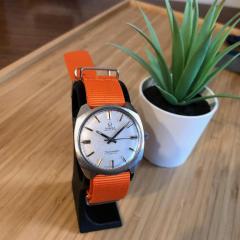Is Bergeon 1896-H a good tool to bore 0.15mm seconds hands to 0.18mm?
-
Recently Browsing
- No registered users viewing this page.
-
Topics
-
Posts
-
By ColChibani · Posted
Donor movement received. Now waiting for a proper & calm time slot to perform the transplant. -
By nevenbekriev · Posted
Hi Joe, I mean the situation when the escapement can be unlocked when pallet fork is pressed as the guard pin to touch the guard roller. This will be possible if the guard pin is short or the depthing of the escapement is not deep enough. The pallet fork was replaced, but I don't think it was adjusted to work correctly with this movement. Of course, if there is defect on the guard roller, it also can lead to such problem. -
Hi everyone, I am new to watch repair and loving the whole process, even some of my fails…maybe. Right now I am looking at purchasing a press for fitting watch crystals, and I was wondering if any of you have had experience with the BMC model (seen in photo) and if you know whether the Robur press dies would fit, or, if not, what alternative dies might as I am having trouble sourcing original ones. I know that the subject of crystal presses has been a well covered topic here, so I apologies for bringing it up again but I hadn’t found any past threads on this points. Any help on this would extremely helpful. Thanks! Joshua
-
By steve1811uk · Posted
Hi, I just wanted to share the unmistakable quality of a Rolex made in approx. 1990. Cleaned and serviced for a friend using appropriate oils and greases, with Epilame on the parts recommended by Rolex. New mainspring and upper setting and jewel for the minute Pinion (cracked jewel). Run in overnight and then worn on the wrist for a couple of hours to warm. Without any adjustment to the balance weights the watch ran at 0 SPD DU, all positions within +3 and -2. Vertical amplitude after 24 hours of 230 degrees minimum. Watch running at zero seconds per day on wrist when worn 24 hours. Serviced just once before 20 years ago. No need to buy the Microstella regulator tool, not this time anyway 🙂 No scratches or damage caused to screw heads and bridges. All seals replaced and waterproof tested to 60 metres. All good practice for when the time comes to service my own Grand Seiko. -
By MariusJacob · Posted
My kid woke me up at 2:00 a.m. I couldn't get back to sleep so I decided to go to the workbench. I was to tired to work on a watch so I decided to dress up tweezers and screwdrivers while having a drink and listening to some music. Luckily I got a comforting nap after lunch and started working on this beautiful Raketa Big Zero.
-







Recommended Posts